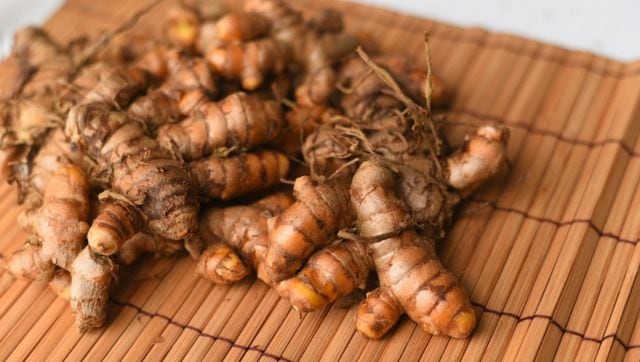High levels of lead have been detected in turmeric samples sold across India. The big question is: Should you be worried?
Turmeric, often called the “golden spice,” is widely valued not only in Indian cuisine but also in traditional medicine for its compound curcumin, which is known to have strong anti-inflammatory and antioxidant properties that support overall health.
However, lead contamination could compromise these benefits and have serious health risks.
ALSO READ |
Heavy metals found in dark chocolate. Is it a cause of concern?
Lead is a toxic heavy metal that, while naturally present in the earth’s crust, can be hazardous to humans, especially if ingested over time.
According to the US Environmental Protection Agency (EPA), lead exposure can be harmful as it mimics calcium, becoming stored in the bones and gradually impacting crucial organs and bodily functions. Lead exposure in humans can come from multiple sources, including air, soil, and water, as well as fossil fuels and lead-based paints.
Given the current findings in turmeric, it is essential to understand the risks and consider safe sourcing options to reduce potential exposure to this heavy metal in everyday spices.
A recent study published in Science of The Total Environment has discovered alarming levels of lead in turmeric samples from India, Pakistan, Nepal, and Sri Lanka, with some samples exceeding 1,000 micrograms per gram (µg/g).
Notably, the Food Safety and Standards Authority of India (FSSAI) permits a maximum lead concentration of only 10 µg/g in turmeric. The study reveals that approximately 14% of the tested samples contained over 2 µg/g of lead, levels that researchers warn could lead to widespread lead poisoning, particularly affecting children.
The research involved sampling turmeric from 23 cities across the four countries between December 2020 and March 2021. In India, the highest lead levels were recorded in Patna (2,274 µg/g) and Guwahati (127 µg/g).
ALSO READ |
India is the world’s diabetes capital. Here’s why samosas, cakes are to blame
Notably, the samples with the highest contamination were polished turmeric roots, often treated to improve their appearance, followed by loose turmeric powders. Packaged and branded turmeric products generally showed lower lead levels, indicating that loose and unregulated turmeric is particularly vulnerable to contamination.
The primary contaminant appears to be lead chromate, a yellow pigment typically used in industrial applications like paints and plastics. Adulteration with lead chromate has been linked to cases of lead poisoning worldwide, including in Bangladesh, where this practice has continued since the 1980s to make low-quality turmeric roots appear more rich.
The study argues that further investigation into the turmeric supply chain is required, particularly focusing on where and why lead chromate enters the production process, despite FSSAI regulations that require turmeric to be free from any extraneous colouring, including lead chromate.
Lead contamination in turmeric can cause serious health risks, especially for children. Even small amounts of lead can impact almost every organ and bodily system, with children under six being the most vulnerable.
Lead exposure in young children is associated with reduced intelligence, behavioural problems, and developmental delays, and it can impair cognitive and behavioural outcomes at blood levels as low as 3.5 µg/dL. Global estimates suggest that over 800 million children currently have blood lead levels above safe thresholds, underscoring the widespread threat of lead exposure.
The WHO estimates that lead contributes to around 600,000 new cases of intellectual impairment in children each year, resulting in approximately 143,000 deaths or 0.6 per cent of the global disease burden. There is no safe level of lead, especially for children.
Turmeric is a daily staple in many South Asian households. The FSSAI has previously responded by issuing consumer advisories with simple methods to detect lead chromate, a contaminant often responsible for elevated lead levels in turmeric.
Researchers warn that the levels found in some turmeric samples could seriously impact cognitive development, with children in areas like Bihar at risk of a potential 7-point IQ reduction compared to unexposed children, Jenna Forsyth, an environmental health scientist who led the study, told The Telegraph.
Lead exposure also affects adults, causing cognitive decline, cardiovascular issues, kidney failure, and increased risks of premature mortality.
What should you do then?
Consumers should make sure to buy turmeric from trusted sources that conduct tests for contaminants. While the presence of lead does not necessarily mean all turmeric is toxic, it calls for the importance of being cautious about the quality of the spice used daily.
Turmeric is not the only food showing signs of contamination – chocolate was also found to contain dangerous levels of heavy metals, according to a study published in Frontiers in Nutrition in July this year.
The study revealed that various popular chocolates in the US and Europe contain heavy metals, such as cadmium and lead, above the limits set by California’s stringent Proposition 65, which enforces some of the strictest chemical safety regulations.
Danielle Fugere, president of the nonprofit As You Sow, explained to USA Today that these heavy metals make their way into chocolate via the cocoa bean. Cocoa plants absorb cadmium from the soil, which then accumulates in the beans, and eventually makes its way into chocolate products.
Dark chocolates, with their higher cocoa content, generally have more heavy metals than milk chocolates, which use less cocoa. Surprisingly, the study found that organic chocolates tend to contain even higher heavy metal levels than conventional ones, likely due to differences in processing or soil composition used in organic farming.
Link to article –
High levels of lead found in turmeric: Is the spice in your food toxic?
